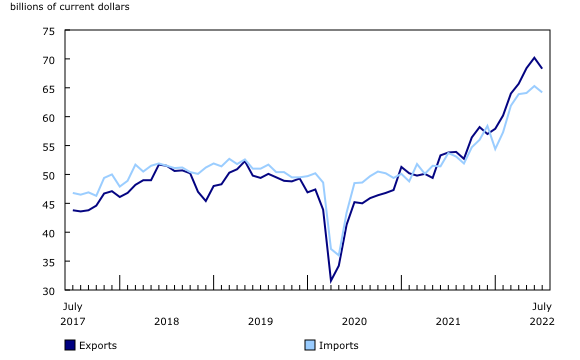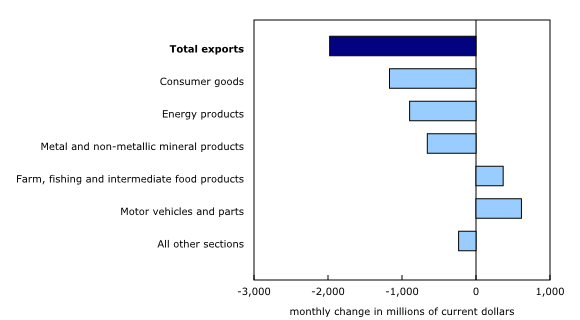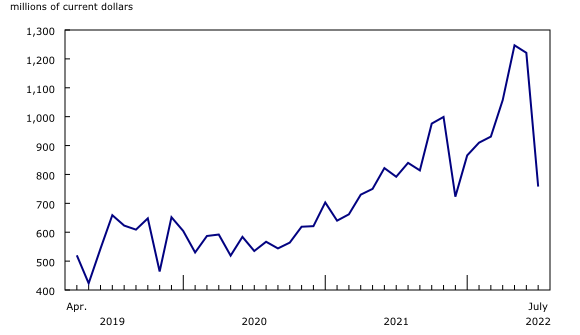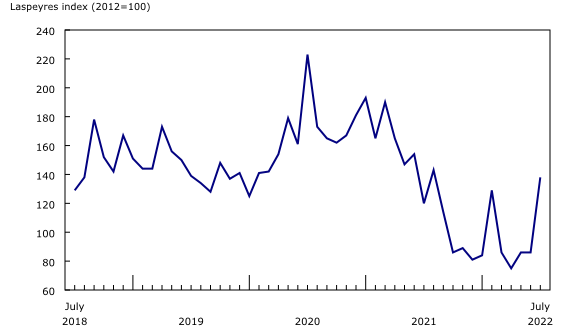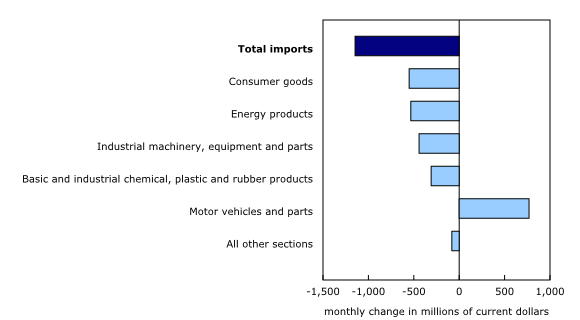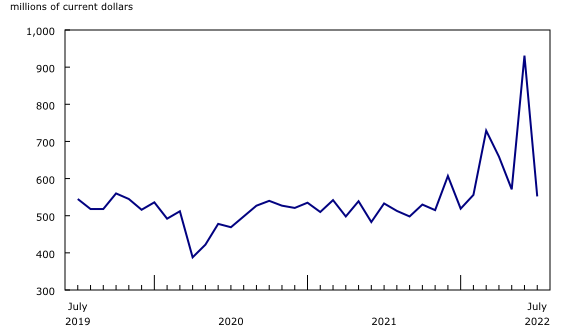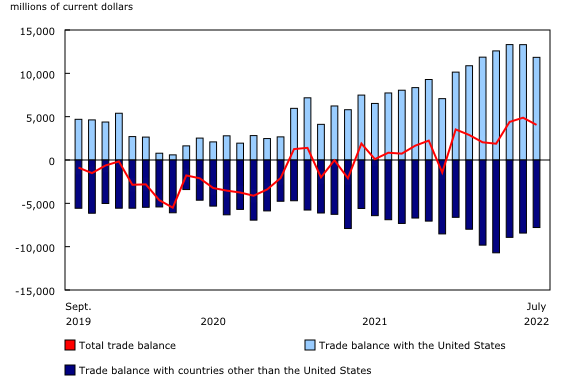Canadian international merchandise trade, July 2022
Released: 2022-09-07
In July, Canada's merchandise exports decreased 2.8%, while imports were down 1.8%. As a result, Canada's merchandise trade surplus with the world narrowed from $4.9 billion in June to $4.1 billion in July. So far in 2022, trade surpluses have been observed in every month.
Consult the "International trade monthly interactive dashboard" to explore the most recent results of Canada's international trade in an interactive format.
First monthly decrease in exports in 2022, amid lower prices
Following six consecutive monthly increases, total exports decreased 2.8% to $68.3 billion in July. Declines were observed in 6 of the 11 product sections. Since the beginning of 2022, the value of exports has risen by almost 20%, and higher prices were behind the bulk of that increase. However, a sharp decrease in prices drove export values down in July, while total exports in real (or volume) terms increased 1.7%, a third consecutive monthly increase.
In July, exports of consumer goods (-14.3%) decreased the most, with exports of pharmaceutical products (-49.1%) falling sharply after a surge in the previous month. In June, large quantities of medications for the treatment of COVID-19 were exported to the United States, Australia and the Netherlands. These shipments were not repeated in July. Lower exports of other types of drugs also contributed to the decline.
Exports of energy products fell 4.2% in July, the first monthly decrease of the year. With oil prices down substantially, export values of crude oil (-4.7%) contributed the most to the decline. On a volume basis, however, crude oil exports were up for a second consecutive month in July. Exports of natural gas (-12.6%) also contributed to the decrease in export values, as both volumes and prices were down in July.
In July, exports of metal and non-metallic mineral products decreased 8.4%. The decline was largely the result of lower exports of unwrought aluminum and aluminum products (-37.9%). Exports of unwrought aluminum have grown steadily in 2022, reaching highs in May and June. While export prices were already at record levels by the end of 2021, Russia's invasion of Ukraine brought prices to new highs. It also resulted in higher demand for Canadian aluminum, which led to higher exported volumes as well, particularly in May and June. In July, however, both volumes and prices were down for exports of unwrought aluminum. This coincided with a recent increase in aluminum output from China, which bolstered global supplies.
Exports of farm, fishing and intermediate food products (+9.1%) partially offset the overall decrease in total exports in July, mainly because of higher exports of wheat (+55.8%). Following record-high exports in 2020, export volumes of wheat dropped at the end of 2021, and lower volumes persisted in the first half of 2022. Amid the expected rebound in wheat production in the new crop year, as well as the conflict in Ukraine, higher supplies from inventories and stronger demand for Canadian wheat pushed export values to a new record high in July.
Imports of consumer goods decrease the most
Total imports fell 1.8% in July to $64.2 billion, the first decrease since January. Declines were observed in 7 of the 11 product sections. In real (or volume) terms, total imports decreased 1.4%.
Imports of consumer goods were down 4.2% in July, a third consecutive monthly decline. Decreases were observed in most subcategories, with imports of miscellaneous goods and supplies (-9.8%) retreating the most. This decrease in July was mainly because of lower imports of gold bars from the United States, which had risen in June. Imports of pharmaceutical products were also down in July, partly because of a decline in imports within the category "vaccines for human medicine other than for influenza," which includes COVID-19 vaccines.
Following a price-driven surge in June, imports of energy products fell 10.2% in July, with both prices and volumes decreasing. As was the case in June, imports of refined petroleum energy products (-15.2%) were the main driver behind the monthly movement in July. Shipments of motor gasoline from the United States, the Netherlands and the United Kingdom were lower in July.
Imports of industrial machinery, equipment and parts (-6.0%) also decreased in July following a strong month in June (+7.6%). Lower imports of the product group "other industry-specific manufacturing machinery" were behind the decrease in July. Imports in this category had been rising lately, partly because of the imports of machinery and parts for the new liquefied natural gas terminal project currently being constructed in British Columbia. Shipments related to this project have fluctuated significantly from month to month, and imports in July were much lower compared with those observed in June. More imports for this project are expected in the months to come.
Higher imports of motor vehicles and parts (+8.4%) partially offset the decrease in total imports. This increase was partly the result of higher imports of motor vehicle engines and parts (+21.0%). Following low levels of production in June in the Canadian auto manufacturing industry, the month-to-month variation in imports of motor vehicle engines and parts in July was less pronounced than usual, leading to a strong seasonally adjusted increase. Many factors have recently been impacting vehicle production in Canada, such as supply chain issues and plant retooling, which contributed to lower imports of motor vehicle engines and parts in May and June. In addition, summer vacation shutdowns in July were slightly less intensive in July 2022 compared with more typical years. These factors also affected exports of passenger cars and light trucks, which were up 6.7% in July.
Exports to the United States decrease for the first time in seven months
Exports to the United States decreased 2.2% in July, partly because of lower exports of crude oil and pharmaceutical products. Meanwhile, imports from the United States increased 0.7%. As a result, Canada's merchandise trade surplus with the United States narrowed from $13.3 billion in June to $11.8 billion in July.
When the average exchange rates for June and July are compared, the Canadian dollar lost 0.8 US cents relative to the American dollar.
Trade deficit with countries other than the United States narrows for third consecutive month
Imports from countries other than the United States decreased 5.7% in July. There were lower imports from the Netherlands (motor gasoline), Switzerland (non-ferrous metals), the United Kingdom (motor gasoline), and India (various products).
Exports to countries other than the United States were down 4.8% in July. Lower exports to the United Kingdom (gold and crude oil), the Netherlands (pharmaceutical products and iron ore), Australia (pharmaceutical products), Peru (diesel and wheat), and China (coal and copper) were partially offset by higher exports to Hong Kong (gold) and South Korea (crude oil, coal and potash).
The merchandise trade deficit with countries other than the United States narrowed from $8.4 billion in June to $7.8 billion in July, the lowest recorded deficit since January.
Revisions to June merchandise export and import data
Imports in June, originally reported at $64.9 billion in the previous release, were revised to $65.3 billion in the release for the current reference month. Exports in June, originally reported at $69.9 billion in the previous release, were revised to $70.2 billion in the current reference month's release.
Monthly trade in services
In July, monthly service exports edged down 0.1% to $12.7 billion. Meanwhile, service imports increased 3.7% to $14.4 billion.
When international trade in goods and international trade in services were combined, exports decreased 2.4% to $80.9 billion in July, while imports fell 0.8% to $78.6 billion. As a result, Canada's trade surplus with the world went from $3.7 billion in June to $2.3 billion in July.
Note to readers
Merchandise trade is one component of Canada's international balance of payments (BOP), which also includes trade in services, investment income, current transfers, and capital and financial flows.
International trade data by commodity are available on both a BOP and a customs basis. International trade data by country are available on a customs basis for all countries and on a BOP basis for Canada's 27 principal trading partners (PTPs). The list of PTPs is based on their annual share of total merchandise trade—imports and exports—with Canada in 2012. BOP data are derived from customs data by adjusting for factors such as valuation, coverage, timing, and residency. These adjustments are made to conform to the concepts and definitions of the Canadian System of National Accounts.
For a conceptual analysis of BOP-based data versus customs-based data, see "Balance of Payments trade in goods at Statistics Canada: Expanding geographic detail to 27 principal trading partners."
For more information on these and other macroeconomic concepts, see the Methodological Guide: Canadian System of Macroeconomic Accounts (13-607-X) and the User Guide: Canadian System of Macroeconomic Accounts (13-606-G).
The data in this release are on a BOP basis and are seasonally adjusted. Unless otherwise stated, values are expressed in nominal terms, or current dollars. References to prices are based on aggregate Paasche (current-weighted) price indexes (2012=100). Movements within aggregate Paasche prices can be influenced by changes in the share of values traded for specific goods, with sudden shifts in trading patterns—as observed currently with the COVID-19 pandemic—sometimes resulting in large movements in Paasche price indexes. Volumes, or constant dollars, are calculated using the Laspeyres formula (2012=100), unless otherwise stated.
For information on seasonal adjustment, see Seasonally adjusted data – Frequently asked questions.
Revisions
In general, merchandise trade data are revised on an ongoing basis for each month of the current year. Current-year revisions are reflected in both the customs-based and the BOP-based data.
The previous year's customs-based data are revised with the release of data for the January and February reference months, and thereafter on a quarterly basis. The previous two years of customs-based data are revised annually, and revisions are released in February with the December reference month.
The previous year's BOP-based data are revised with the release of data for the January, February, March and April reference months. To remain consistent with the Canadian System of Macroeconomic Accounts, revisions to BOP-based data for previous years are released annually in December with the October reference month.
Factors influencing revisions include the late receipt of import and export documentation, incorrect information on customs forms, the replacement of estimates produced for the energy section with actual figures, changes in merchandise classification based on more current information, and changes to seasonal adjustment factors. The seasonal adjustment parameters are reviewed and updated annually and applied with the October reference month release.
For information on data revisions for exports of energy products, see Methodology for Exports of Energy Products within the International Merchandise Trade Program.
Revised data are available in the appropriate tables.
Real-time data table
The real-time data table 12-10-0120-01 will be updated on September 19.
Next release
Data on Canadian international merchandise trade for August will be released on October 5.
Products
The product "International trade monthly interactive dashboard" (71-607-X) is now available. This new interactive dashboard is a comprehensive analytical tool that presents monthly changes in Canada's international merchandise trade data on a balance-of-payments basis, fully supporting the information presented every month in the Daily release.
The product "The International Trade Explorer" (71-607-X) is now available online.
The Canadian International Merchandise Trade online database is no longer available. It has been replaced by the Canadian International Merchandise Trade Web Application (71-607-X), a modern tool that provides trade data users with a number of enhancements.
The updated "Canada and the World Statistics Hub" (13-609-X) is now available online. This product illustrates the nature and extent of Canada's economic and financial relationship with the world using interactive charts and tables. It provides easy access to information on trade, investment, employment and travel between Canada and a number of countries, including the United States, the United Kingdom, Mexico, China, Japan, Belgium, Italy, the Netherlands and Spain.
Contact information
For more information, or to enquire about the concepts, methods or data quality of this release, contact us (toll-free 1-800-263-1136; 514-283-8300; infostats@statcan.gc.ca) or Media Relations (statcan.mediahotline-ligneinfomedias.statcan@statcan.gc.ca).
- Date modified:


